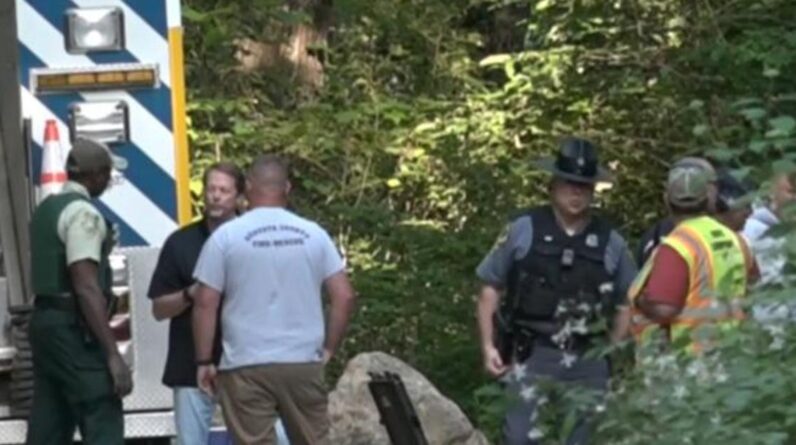
Many questions remain afterwards an unresponsive plane crashed in Virginia after flying over restricted airspace in Washington, DC on Sunday. The plane, a Cessna 560 Citation V, was a private jet registered to a Florida-based company owned by John and Barbara Rumpel. John Rumpel said her daughter, 2-year-old granddaughter and a babysitter were on board.
All three passengers and the pilot, who remained unresponsive during the ordeal, were killed and the plane crashed near the George Washington National Forest in Virginia. The cause of the incident is being investigated by the Federal Aviation Administration and the National Transportation Safety Board.
What caused the accident?
It’s unclear why the pilot didn’t respond, but CBS News aviation safety analyst Robert Sumwalt, former chairman of the National Transportation Safety Board, said the plane likely continued to fly on autopilot after the pilot was incapacitated due to hypoxia.
“There have been events where the plane has been depressurized or not pressurized, and so everybody on the plane becomes hypoxic,” he said. At higher altitudes, the air is thinner and has less oxygen. People on board an airplane can suffer hypoxia if the plane is not pressurized properly, first falling asleep and eventually dying.
This happened in 1999, when golfer Payne Stewart’s chartered jet lost pressure and could not get oxygen. The plane flew on autopilot for four hours and crashed near Aberdeen, South Dakota. All six people on board died.
The occurrence and severity of hypoxia is caused by several factors, including the rate of ascent and even a person’s physiological fitness, according to the FAA. It cannot be predicted, but it can be prevented by flying “a well-maintained pressurized aircraft” as well as flying at an altitude where oxygen is not required. A pilot’s inability to detect hypoxia is responsible for many incidents, according to the FAA.
Hypoxia has also occurred before on commercial flights. Sumwalt cited a 2005 accident in which the crew of a 737 failed to adjust the pressurization properly and the plane never pressurized, so it flew until it ran out of fuel and crashed in Greece. All 115 passengers and six crew members died. according to the FAA.
If a pilot is incapacitated, a plane could fly on autopilot until it runs out of fuel, which Sumwalt said likely happened in the recent incident in Virginia.
Sumwalt, a retired 737 captain, says many small planes don’t require two pilots and the standard is based on the weight of the plane.
“This aircraft itself requires two pilots, but with an exemption, one pilot can be a single-pilot operation,” he said. If the plane is equipped so that a single pilot can fly it alone and the pilot demonstrates that he can fly the plane without a second pilot, a waiver can be granted, Sumwalt said.
It is not clear if the pilot had an exemption to fly alone, however is possible for this model to fly itself, with FAA certification.
How high and how fast can a private jet fly?
Commercial airplanes usually reach 35,000 feet but small private jets can fly up to 41,000 feet or even higher, in accordance with multiple private jet corridors.
The Cessna Citation V, which, like its smaller counterpart, the Cessna Citation II, seats eight passengers, can reach 45,000 feet.
How expensive are private jets?
In one private jet charter site, the price to rent a Cessna Citation V is $3,250 an hour. The price to buy one could be as steep as $2.2 million, plus the price of maintenance, fuel and crew. In 2016, Aircraft Owners and Pilots Association he said the average price for a 1989 model was $900,000 and the average for a 1994 model was $1.3 million.
Larger planes like a 747 cost hundreds of millions of dollars. The average cost of rent a Boeing 747 it’s $30,950 an hour.
How common are private jet crashes?
Last year, the Aircraft Owners and Pilots Association, which advocates for aviation, recorded 968 accidents involving non-commercial aircraft. Almost 160 of these accidents were fatal and 264 people died.
Only 21, or 2.2 percent, of the crashes were determined to be pilot-related, but a whopping 826, or 85.3 percent, have causes yet to be determined.
About 200 of the recorded non-commercial aircraft accidents involved private aircraft, such as the one involved in this incident. And of all the accidents recorded, only 70 had a second pilot on board.
After the unresponsive plane flew over restricted airspace, the US military deployed fighter jets to intercept the plane, causing a sonic boom in the area. The military monitored the plane until it left the area, and a US official told CBS News that the Cessna was not shot down by the F-16s.
Although there are far fewer aviation fatalities compared to automobile fatalities, private jets have a higher chance of crashing than commercial jets. according to FAA data. Charter pilots come under far less regulatory scrutiny than commercial pilots, and commercial aircraft have more protections, including frequent maintenance, checks and training for pilots and crew.
Pilot error accounts for more than half of fatal airplane accidents. Because of this, the FAA limits the flight time of commercial crews and requires rest periods.
Trending news
Caitlin O’Kane
[ad_2]
Source link






